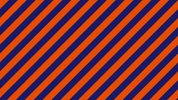linePatternD01 
Function call: fn_linePatternD01 (uv, color1, color2, number, edgeSharpness);
Example with values: fn_linePatternD01 (uv, float3(0.1, 0.1, 0.4), float3(0.9, 0.3, 0.0), 20.0, 1000.0);
(Result see image)
Purpose:
Creates a pattern of a selectable number of symmetrical diagonal 45° lines
of alternating color or brightness or another RGB source.
This can be a color, or a texture from a sampler.
Adjustable edge softness of the squares.
More details see the parameter descriptions.
Required global definitions and declarations:
(add outside and above all shaders and functions):
//-----------------------------------------------------------------------------------------//
// Definitions and declarations
//-----------------------------------------------------------------------------------------//
float _OutputAspectRatio;
#define PI 3.141592654
Code (Example as a float3 RGB function without alpha):
float3 fn_linePatternD01 (float2 uv, float3 color1, float3 color2, float number, float edgeSharpness)
{
float mix = uv.x + (uv.y / _OutputAspectRatio);
mix = sin (mix * PI * number ) * edgeSharpness / number;
return lerp (color1, color2, clamp( mix, -0.5, 0.5) + 0.5);
}
When making code changes, note that color1 and color2 must have the same float type.
Code description at the bottom of this page.
Parameter Description
uv:
Enter the name of the used texture coordinate variable.
Type:float2
color1:
Color of the first square at the top left.
Type:float3(RGB)- This can be a color, or a texture from a sampler.
color2:
Color of the squares next tocolor1squares.
Type:float3(RGB)- This can be a color, or a texture from a sampler.
number:
The number of lines of both colors, counted only at the top or bottom edge of the frame.
Type:float
Value range: > +1 or < -1
Illegal value is 0 (leads to division by 0)
edgeSharpness:
Edge sharpness of the squares
Type:float
Value range: > +1 or < -1
Values around 1000 and above result in relatively sharp edges for HD formats.
At 200 and below, the edge smoothness is clearly visible.
Return value:
- The value of the parameter
color1orcolor2(in the change of squares) - Type: float3 (same type as
color1andcolor2) - Value range: 0.0 to 1.0
Code description
The code at the top of this page is compressed.
For a better understanding, the uncompressed code is described here:
float3 fn_linePatternD01 (float2 uv, float3 color1, float3 color2, float number, float edgeSharpness)
{
float mix = uv.x + (uv.y / _OutputAspectRatio);
mix = sin (mix * PI * number );
mix *= edgeSharpness / number;
mix = clamp( mix, -0.5, 0.5); // range -0.5 +0.5
mix += 0.5 ; // range 0 to 1
return lerp (color1, color2, mix);
}
Code description:
float mix = uv.x + (uv.y / _OutputAspectRatio); This produces a value that is constant in the diagonal direction,
from bottom left to top right, at a 45 ° angle.
This makes the lines created in the following lines of code diagonal.
mix = sin (mix * PI * number ); Creates a diagonal wave pattern ( value range from -1 to +1).
The following two lines of code increase the sharpness:
mix *= edgeSharpness / number;
mix = clamp( x, -0.5, 0.5); // range -0.5 +0.5`
` mix += 0.5 ; ` Move to the normal range from 0 to 1
return lerp (color1, color2, mix); Assignment to the set colors.
If you only need black and white lines then you can simplify the code by returning the mix variable.
Screenshot
